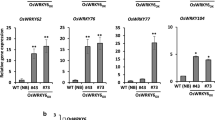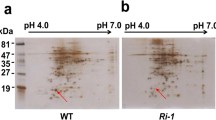Abstract
Key message
OsICS1 but not OsICS1-L mediates the rice response to Xoo inoculation, with its overexpression increasing resistance against this pathogen. OsICS1 but not OsICS-L is directly upregulated by OsWRKY6.
Abstract
Rice (Oryza sativa) is a staple crop for about half of the global population and is particularly important in the diets of people living in Asia, Latin America, and Africa. This crop is continually threatened by bacterial leaf blight disease caused by Xanthomonas oryzae pv. oryzae (Xoo), which drastically reduces yields; therefore, it is needed to elucidate the plant’s resistance mechanisms against Xoo. Isochorismate synthase (ICS1) generates salicylic acid (SA) and increases resistance against bacterial disease. The OsICS1 is differently annotated in rice genome databases and has not yet been functionally characterized in the context of Xoo infection. Here, we report that the expression of the OsICS1 is directly regulated by OsWRKY6 and increases plant resistance against Xoo. Inoculation with Xoo increased the expression of OsICS1 but not that of the long variant of OsICS1 (OsICS1-L). OsWRKY6 directly activated the OsICS1 promoter but not the OsICS1-L promoter. OsICS1 overexpression in rice increased resistance against Xoo through the induction of SA-dependent bacterial defense genes. These data show that OsICS1 promotes resistance against Xoo infection.




Similar content being viewed by others
Data availability
The data and materials that support the findings of this study are openly available from the corresponding author K-HH upon reasonable request.
Abbreviations
- ChIP:
-
Chromatin immunoprecipitation
- GUS:
-
β-Glucuronidase
- ICS:
-
Isochorismate synthase
- SA:
-
Salicylic acid
- Xoo :
-
Xanthomonas oryzae Pv. oryzae
References
Bakade R, Ingole KD, Deshpande S, Pal G, Patil SS, Bhattacharjee S, Prasannakumar MK, Ramu VS (2021) Comparative transcriptome analysis of rice resistant and susceptible genotypes to Xanthomonas oryzae pv. oryzae identifies novel genes to control bacterial leaf blight. Mol Biotechnol 63(8):719–731. https://doi.org/10.1007/s12033-021-00338-3
Choi C, Hwang SH, Fang IR, Kwon SI, Park SR, Ahn I, Kim JB, Hwang DJ (2015) Molecular characterization of Oryza sativa WRKY6, which binds to W-box-like element 1 of the Oryza sativa pathogenesis-related (PR) 10a promoter and confers reduced susceptibility to pathogens. New Phytol 208(3):846–859. https://doi.org/10.1111/nph.13516
Choi N, Im JH, Lee E, Lee J, Choi C, Park SR, Hwang DJ (2020) WRKY10 transcriptional regulatory cascades in rice are involved in basal defense and Xa1-mediated resistance. J Exp Bot 71(12):3735–3748. https://doi.org/10.1093/jxb/eraa135
Eulgem T, Rushton PJ, Robatzek S, Somssich IE (2000) The WRKY superfamily of plant transcription factors. Trends Plant Sci 5(5):199–206. https://doi.org/10.1016/s1360-1385(00)01600-9
Fukushima S, Mori M, Sugano S, Takatsuji H (2016) Transcription factor WRKY62 plays a role in pathogen defense and hypoxia-responsive gene expression in rice. Plant Cell Physiol 57(12):2541–2551. https://doi.org/10.1093/pcp/pcw185
Garcion C, Lohmann A, Lamodiere E, Catinot J, Buchala A, Doermann P, Metraux JP (2008) Characterization and biological function of theISOCHORISMATE SYNTHASE2 gene of Arabidopsis. Plant Physiol 147(3):1279–1287. https://doi.org/10.1104/pp.108.119420
Group RWW (2012) Nomenclature report on rice WRKY’s—Conflict regarding gene names and its solution. Rice (n y) 5(1):3. https://doi.org/10.1186/1939-8433-5-3
Hwang SH, Lee IA, Yie SW, Hwang DJ (2008) Identification of an OsPR10a promoter region responsive to salicylic acid. Planta 227(5):1141–1150. https://doi.org/10.1007/s00425-007-0687-8
Im JH, Choi C, Park SR, Hwang DJ (2022) The OsWRKY6 transcriptional cascade functions in basal defense and Xa1-mediated defense of rice against Xanthomonas oryzae pv. oryzae. Planta 255(2):47. https://doi.org/10.1007/s00425-022-03830-5
Jiang N, Yan J, Liang Y, Shi Y, He Z, Wu Y, Zeng Q, Liu X, Peng J (2020) Resistance genes and their interactions with bacterial blight/leaf streak pathogens (Xanthomonas oryzae) in rice (Oryza sativa L.)—an updated review. Rice 13(1):1–12
Koo SC, Moon BC, Kim JK, Kim CY, Sung SJ, Kim MC, Cho MJ, Cheong YH (2009) OsBWMK1 mediates SA-dependent defense responses by activating the transcription factor OsWRKY33. Biochem Biophys Res Commun 387(2):365–370. https://doi.org/10.1016/j.bbrc.2009.07.026
Lee HY, Byeon Y, Tan DX, Reiter RJ, Back K (2015) Arabidopsis serotonin N-acetyltransferase knockout mutant plants exhibit decreased melatonin and salicylic acid levels resulting in susceptibility to an avirulent pathogen. J Pineal Res 58(3):291–299. https://doi.org/10.1111/jpi.12214
Lefevere H, Bauters L, Gheysen G (2020) Salicylic acid biosynthesis in plants. Front Plant Sci 11:338. https://doi.org/10.3389/fpls.2020.00338
Liu W, Liu J, Triplett L, Leach JE, Wang G-L (2014) Novel insights into rice innate immunity against bacterial and fungal pathogens. Annu Rev Phytopathol 52:213–241
Liu Q, Li X, Yan S, Yu T, Yang J, Dong J, Zhang S, Zhao J, Yang T, Mao X, Zhu X, Liu B (2018) OsWRKY67 positively regulates blast and bacteria blight resistance by direct activation of PR genes in rice. BMC Plant Biol 18(1):257. https://doi.org/10.1186/s12870-018-1479-y
Meher J, Lenka S, Sarkar A, Sarma BK (2023) Transcriptional regulation of OsWRKY genes in response to individual and overlapped challenges of Magnaporthe oryzae and drought in indica genotypes of rice. Environ Exp Bot 207:105221
Nawrath C, Metraux JP (1999) Salicylic acid induction-deficient mutants of Arabidopsis express PR-2 and PR-5 and accumulate high levels of camalexin after pathogen inoculation. Plant Cell 11(8):1393–1404. https://doi.org/10.1105/tpc.11.8.1393
Nino-Liu DO, Ronald PC, Bogdanove AJ (2006) Xanthomonas oryzae pathovars: model pathogens of a model crop. Mol Plant Pathol 7(5):303–324. https://doi.org/10.1111/j.1364-3703.2006.00344.x
Qiu D, Xiao J, Ding X, Xiong M, Cai M, Cao Y, Li X, Xu C, Wang S (2007) OsWRKY13 mediates rice disease resistance by regulating defense-related genes in salicylate- and jasmonate-dependent signaling. Mol Plant Microbe Interact 20(5):492–499. https://doi.org/10.1094/MPMI-20-5-0492
Sharma A, Sidhu GPS, Araniti F, Bali AS, Shahzad B, Tripathi DK, Brestic M, Skalicky M, Landi M (2020) The role of salicylic acid in plants exposed to heavy metals. Molecules 25(3):540. https://doi.org/10.3390/molecules25030540
Son S, An HK, Seol YJ, Park SR, Im JH (2020) Rice transcription factor WRKY114 directly regulates the expression of OsPR1a and Chitinase to enhance resistance against Xanthomonas oryzae pv. oryzae. Biochem Biophys Res Commun 533(4):1262–1268. https://doi.org/10.1016/j.bbrc.2020.09.141
Son S, Im JH, Song G, Nam S, Park SR (2022) OsWRKY114 inhibits ABA-induced susceptibility to Xanthomonas oryzae pv. oryzae in rice. Int J Mol Sci 23(15):8825. https://doi.org/10.3390/ijms23158825
Song G, Son S, Lee KS, Park YJ, Suh EJ, Lee SI, Park SR (2022) OsWRKY114 negatively regulates drought tolerance by restricting stomatal closure in rice. Plants (basel) 11(15):1938. https://doi.org/10.3390/plants11151938
Wang X, Gao J, Zhu Z, Dong X, Wang X, Ren G, Zhou X, Kuai B (2015) TCP transcription factors are critical for the coordinated regulation of ISOCHORISMATE SYNTHASE 1 expression in Arabidopsis thaliana. Plant J 82(1):151–162. https://doi.org/10.1111/tpj.12803
Wang F, Tan H, Zhang Y, Huang L, Bao H, Ding Y, Chen Z, Zhu C (2021) Salicylic acid application alleviates cadmium accumulation in brown rice by modulating its shoot to grain translocation in rice. Chemosphere 263:128034. https://doi.org/10.1016/j.chemosphere.2020.128034
Wildermuth MC, Dewdney J, Wu G, Ausubel FM (2001) Isochorismate synthase is required to synthesize salicylic acid for plant defence. Nature 414(6863):562–565
Wu KL, Guo ZJ, Wang HH, Li J (2005) The WRKY family of transcription factors in rice and Arabidopsis and their origins. DNA Res 12(1):9–26. https://doi.org/10.1093/dnares/12.1.9
Xu J, Audenaert K, Hofte M, De Vleesschauwer D (2013) Abscisic acid promotes susceptibility to the rice leaf blight pathogen Xanthomonas oryzae pv oryzae by suppressing salicylic acid-mediated defenses. PLoS ONE 8(6):e67413. https://doi.org/10.1371/journal.pone.0067413
Yu S, Ligang C, Liping Z, Diqiu Y (2010) Overexpression of OsWRKY72 gene interferes in the abscisic acid signal and auxin transport pathway of Arabidopsis. J Biosci 35(3):459–471. https://doi.org/10.1007/s12038-010-0051-1
Zhang Y, Li X (2019) Salicylic acid: biosynthesis, perception, and contributions to plant immunity. Curr Opin Plant Biol 50:29–36. https://doi.org/10.1016/j.pbi.2019.02.004
Acknowledgements
This research was supported by the Brain Pool program funded by the Ministry of Science and ICT through the National Research Foundation of Korea (RS-2023-00262576) to J.I. This study was carried out with the support of the “Research Program for Agricultural Science & Technology Development (Project No. PJ01246303)”, National Institute of Agricultural Sciences, Rural Development Administration, Republic of Korea, and also supported by “Regional Innovation Strategy (RIS)” through the National Research Foundation of Korea (NRF) funded by the Ministry of Education (MOE)(2023RIS-009).
Author information
Authors and Affiliations
Contributions
JI, CC, DH: conceptualization; JI, DH: funding acquisition; JI, MJ, CC: investigation; JI, CC, SP: methodology; DH: project administration; DH: supervision; JI, CC: visualization; JI, DH, MJ: writing and revision.
Corresponding author
Ethics declarations
Conflict of interest
The authors declare no conflict of interest.
Additional information
Communicated by Dorothea Bartels.
Publisher's Note
Springer Nature remains neutral with regard to jurisdictional claims in published maps and institutional affiliations.
Supplementary Information
Below is the link to the electronic supplementary material.
425_2024_4405_MOESM1_ESM.pptx
Supplementary file1 Fig. S1 Primer sets for the RT-qPCR in OsICS1 and an epitope of the anti-OsICS1 antibody. Fig. S2 Expression of OsWRKY6 in three-week-old OsWRKY6 overexpressing (OsWRKY6OX) plants, as determined using RT-qPCR. Values are means ± SD (n= 3, **P < 0.01). Fig. S3 Protein blot analysis of OsICS1 in 3-week-old OsWRKY6-overexpressing (OsWRKY6OX) plants. The protein blot analysis was performed using an anti-OsICS1 antibody and OsWRKY6 antibody (Choi et al. 2015). Anti-histone 3 (H3) antibody was used for the loading control. Fig. S4 Disease incidence in OsICS1 overexpressing plants. OsICS1OX plants were inoculated at 9 weeks old with compatible XooKXO576 using the scissor-dip method. After 2 weeks, the image of the leaves was taken. Bar = 10 cm. (PPTX 661 KB)
Rights and permissions
Springer Nature or its licensor (e.g. a society or other partner) holds exclusive rights to this article under a publishing agreement with the author(s) or other rightsholder(s); author self-archiving of the accepted manuscript version of this article is solely governed by the terms of such publishing agreement and applicable law.
About this article
Cite this article
Im, J.H., Choi, C., Jung, MY. et al. The OsICS1 is directly regulated by OsWRKY6 and increases resistance against Xanthomonas oryzae pv. oryzae. Planta 259, 124 (2024). https://doi.org/10.1007/s00425-024-04405-2
Received:
Accepted:
Published:
DOI: https://doi.org/10.1007/s00425-024-04405-2




